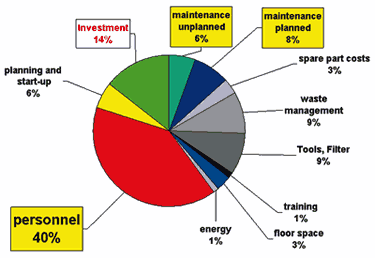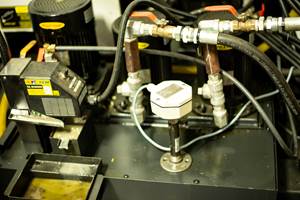The Returns On Automation
Machine tool automation, particularly grinding machine automation, offers various returns on investment. Different shops notice different advantages, and sometimes shops overlook important benefits when they are deciding whether to automate.
Share





This is the case with almost any capital equipment purchase, and it’s the case with automation, too: When considering whether the purchase makes sense, price does not tell the whole story. Machine tool automation earns returns in various ways, some of which will be more or less valuable to different shops, and all of the returns on automation deserve to be figured into the analysis.
Of course, the most obvious promise of automation hardware is the chance to run unattended, or more specifically, the chance to keep producing with the machine tool after all of the operators have left for the day. An automated parts-loading system might make the machine tool seem considerably more expensive if it adds 30 percent to the overall price. However, what if that same parts-loading system allows the machine to continue making parts through 12 hours per day when no operator is present? The shop would therefore get twice the productive output of the machine for just 1.3 times the price.
Even When Operators Are Present
John Richard is a sales director for grinding machine maker Fritz Studer AG (represented in the U.S. by United Grinding). This company’s grinding machines are used with various automation options in various applications at various price ranges, but Mr. Richard says the scenario of 30 percent more price for 100 percent more productive time is not at all unrealistic. In fact, he says it’s common. However, he also says that automation can pay its way even if unattended machining is not in the cards for the shop or plant. The various other sources of return on investment for automation include the following:
- Speed. Studer’s “easyLoad” system, which is shown on this page, can load a part into a cylindrical grinding machine in about 6 to 12 seconds, depending on a variety of factors including the size of the part. An operator loading workpieces into the machine by hand would take longer—about 10 to 15 seconds. This seemingly slight speed difference between automatic and manual loading may be meaningless if the grinding cycle time is long. However, if the grinding cycle time is short, the saved seconds may produce more output during the course of the production run. More significantly, the automatic loader does not get tired. Its speed remains the same, even late into the shift.
- Consistency. How valuable is it to be able to accurately predict how long the entire production run of a part will take? Knowing just the machining cycle time is not enough to make this prediction. The amount of time between each cycle—that is, the load and unload time—is a variable as long as it relies on human beings. This variable is influenced by which operator is doing the loading, how the operator is feeling at that moment and to what extent the operator gets distracted. By contrast, automation turns the load/unload time into a fixed and repeatable value (in addition to potentially shortening this time). Gaining certainty about the total time required for a production run makes it possible for the plant to schedule equipment more accurately, which in turn makes it more likely that the plant can get the most value from equipment by fully employing its machines.
- Increased output per operator. A plant that depends on operators to load its machines has to add both machines and people in order to increase its volume. However, a plant that uses at least some automation can add machines without necessarily adding people, making it that much easier to quickly respond to increasing demand.
For example, if two grinding machines both rely on part-loading systems such as the one mentioned above, then each of those machines can run without an operator through a succession of workpieces instead of through just one machining cycle. As a result, the same operator that might have been busy attending to just one of these machines in the past can now be free to leave the machine for a longer period of time. He or she can then use this time to load the staging area of a second machine that is similarly equipped to run unattended—meaning this operator now keeps two machines producing instead of one. The extra price for the two part-loading systems therefore saves the shop the costs of both finding and employing an additional operator.
Even When The Lights Are On
Mr. Richard says grinding machine users he consults with consider either long- or short-cycle-time parts to be more appropriate for automation. That is, different shops have different opinions, believing that either the long-running parts or short-running parts are better able to be automated. The perspective depends on the shop’s experience and what return on automation that shop has come to expect. Both types of parts are potentially suited to automation—it’s just that the reason for automating varies.
For parts with short cycle times, the principle reason to automate is productivity. If the part is relatively lightweight, an automated system is likely to load and unload the part faster than a human being can, and this loading time advantage will accumulate over time. The consistency of part load/unload times will also allow the plant to schedule machines more effectively.
For parts with long cycle times, the reason to automate is unattended machining. Filling the staging area of the automated loading system with a run of long-cycle-time parts can be enough to let the machine keep producing without an operator for hours into the night, perhaps all the way through to the morning.
However, Mr. Richard stresses that unattended machining is something larger than just “lights-out” machining. Even if the shop is staffed around the clock, what happens to the machine tool when the operator takes a lunch break or steps away from the machine to ask a question about the next job? With automation, the machine doesn’t have to sit idle if the machining cycle ends before the operator makes his or her way back to the machine. This extra productivity during otherwise idle periods of each typical day can sum to significantly more output over the course of the year.
How Much Of The Machine?
One way to look at any machine tool purchase, says Mr. Richard, is to ask what portion of the machine’s output the shop will be able to put to use. The machine could potentially produce through any hour of the day. The hours that go unrealized therefore represent capacity the shop paid for without actually obtaining. In other words, the number of hours per day that the machine spends actually machining will determine how much of that machine—1/2 of the machine? 2/3 of it?—the shop is actually buying for the price. Automation increases the price, but overall, it lets the shop obtain a much higher percentage of the value of what it’s buying.
Related Content
Investing in Automation, Five-Axis to Increase Production Capacity
To meet an increase in demand, this shop invested heavily in automation solutions and five-axis machines to ramp up its production capabilities.
Read More3 Ways Artificial Intelligence Will Revolutionize Machine Shops
AI will become a tool to increase productivity in the same way that robotics has.
Read More4 Steps to a Cobot Culture: How Thyssenkrupp Bilstein Has Answered Staffing Shortages With Economical Automation
Safe, economical automation using collaborative robots can transform a manufacturing facility and overcome staffing shortfalls, but it takes additional investment and a systemized approach to automation in order to realize this change.
Read MoreManaging Coolant with Skimmers, Refractometers and More
Bacteria-infected coolant harms machines and sickens machinists. Coolant management technologies like skimmers and automated systems counter this tendency.
Read MoreRead Next
5 Rules of Thumb for Buying CNC Machine Tools
Use these tips to carefully plan your machine tool purchases and to avoid regretting your decision later.
Read MoreRegistration Now Open for the Precision Machining Technology Show (PMTS) 2025
The precision machining industry’s premier event returns to Cleveland, OH, April 1-3.
Read More




















.png;maxWidth=300;quality=90)








.jpg;maxWidth=300;quality=90)









.png;maxWidth=970;quality=90)